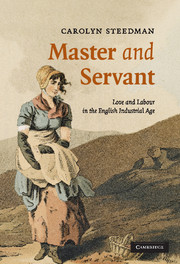Book contents
- Frontmatter
- Contents
- List of maps
- Acknowledgements
- Map 1 Map of the Haworth, Slaithwaite, Huddersfield and Halifax region, 1795
- Map 2 Sketch map of the woollen and worsted producing areas of the West Riding, late eighteenth century
- Prologue
- 1 Introduction: on service and silences
- 2 Wool, worsted and the working class: myths of origin
- 3 Lives and writing
- 4 Labour
- 5 Working for a living
- 6 Teaching
- 7 Relations
- 8 The Gods
- 9 Love
- 10 Nelly's version
- 11 Conclusion: Phoebe in Arcadia
- Bibliography
- Index
8 - The Gods
Published online by Cambridge University Press: 06 January 2010
- Frontmatter
- Contents
- List of maps
- Acknowledgements
- Map 1 Map of the Haworth, Slaithwaite, Huddersfield and Halifax region, 1795
- Map 2 Sketch map of the woollen and worsted producing areas of the West Riding, late eighteenth century
- Prologue
- 1 Introduction: on service and silences
- 2 Wool, worsted and the working class: myths of origin
- 3 Lives and writing
- 4 Labour
- 5 Working for a living
- 6 Teaching
- 7 Relations
- 8 The Gods
- 9 Love
- 10 Nelly's version
- 11 Conclusion: Phoebe in Arcadia
- Bibliography
- Index
Summary
Given the number of social and cultural historians who have roamed the worsted field from the early eighteenth century onwards, we should expect to know a good deal about the ideological context to the life of its people. Belief systems of the West Riding, both official and personal, have been described by many kinds of historian, not only those who have focused on the Anglican Church. It was among these hills and valleys that Edward Thompson located his making of the English working class, in the years between 1780 and 1830. According to Callum Brown, he and other social historians of the 1960s and 1970s were forced to concede the power of religion in the making of popular political consciousness (and perhaps in the making of class), but only by concentrating on Methodism, and then by placing Methodism's fervent adherents in ideological opposition to those who planted the Liberty Tree. For the Methodists there was the chiliasm of despair, a febrile escape from the social and political circumstances that produced it; for other, less godly men and women, the making of class consciousness through a rational apprehension of the meaning of their experience, as both workers and political subjects.
It is indeed difficult to square the religious formation of your historical subjects with the politically conscious men whom you now – in 1963 – represent as their historians.
- Type
- Chapter
- Information
- Master and ServantLove and Labour in the English Industrial Age, pp. 152 - 175Publisher: Cambridge University PressPrint publication year: 2007
- 1
- Cited by

